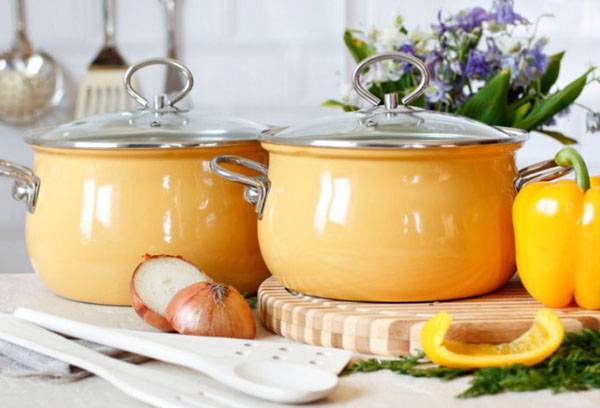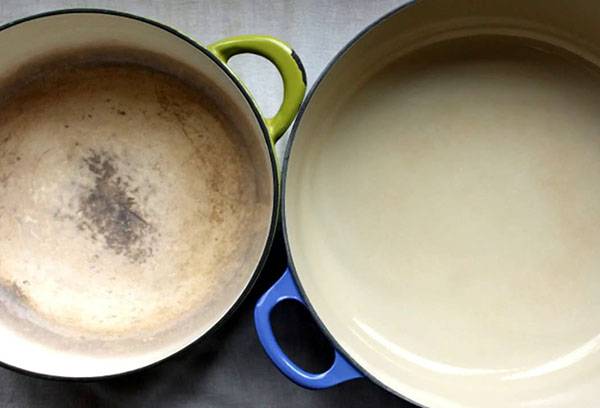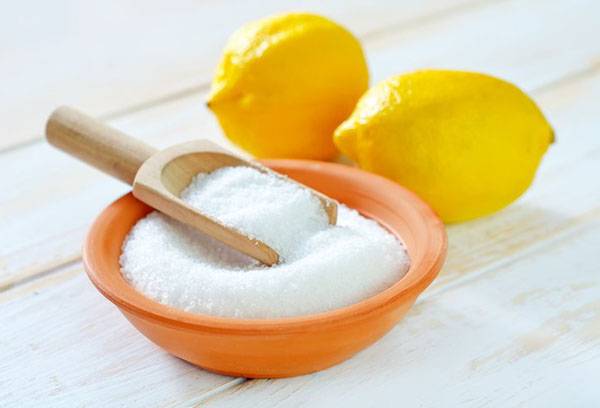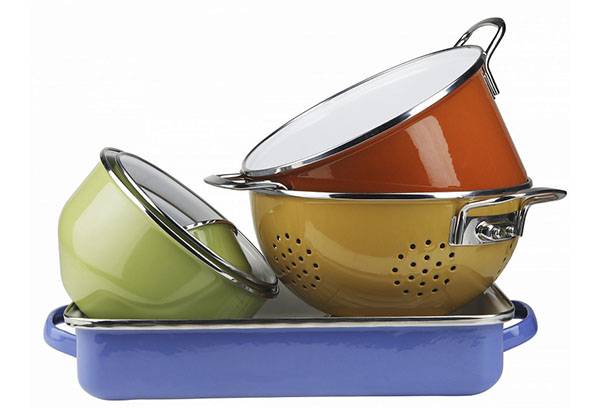Effective means for bleaching enamel cookware
How to bleach an enamel pan? Due to poor quality water, a dark coating appears, some foods can stain the walls, and sometimes you can miss the moment, and then the food will burn. But there are ways to help restore utensils to their original cleanliness.

Features of care
The main difficulty associated with caring for enamel pans is that if not handled carefully, the enamel can chip. Such cookware is unsuitable for use; nothing can be cooked in it. It is only useful for storing bulk substances. The use of abrasive cleaning agents and metal sponges is not allowed: they leave micro-scratches, which soon turn into cracks. As a result, the coating breaks off.
Enamel does not react well to sudden temperature changes. You cannot place a pan covered with it on a heated electric stove, or pour cold water into a hot dish. You need to wait until it cools down.
Of course, proper care helps keep kitchen utensils in good condition. But still, its appearance may worsen over time. Whatever the reason - hard tap water or burnt food - you need to start cleaning without delay. Dirt eats into the enamel, and later it will be more difficult to wash it off. If at the moment it is not possible to do this, then you need to pour water into the container.
How to clean dishes
Minor stains can be removed at home using regular dishwashing detergent and a moderately hard sponge. If there are lumps of food on the walls that simply cannot be removed, then it is recommended to fill the pan with water, add liquid detergent to it and let it sit for an hour.
It is not always so easy to bleach dishes. If scale or burnt pieces of food remain, there is no need to look for a particularly expensive and effective cleaning product. It is worth using products that are likely to be found in every home.
Our mothers and grandmothers also cleaned enamel utensils using the following means:
- coffee grounds;
- salt;
- soda;
- activated carbon;
- vinegar;
- apple peel.
All of them are quite effective. There are situations when the chosen remedy does not help. Don't despair, it's better to try another method.
Using coffee grounds, salt and soda
Coffee grounds are used if you need to bleach a container after burnt milk. It helps dissolve carbon deposits so that the whiteness of the vessel returns.
The saline solution has worked well. It’s very simple to make: add 5 large spoons of salt to a liter of water and stir until completely dissolved. Pour the product into the pan and leave for a couple of hours. The process can be speeded up if the container filled with the solution is placed on low heat for half an hour. Most often, this is enough to restore the original appearance of the dishes.
Advice
You can boil several peeled onions in a saucepan. This will help return her to her previous condition.
Another substance that copes well with a variety of stains, including yellowness, is soda.Just remember that you can’t just apply it to a sponge and rub the walls, because the enamel does not tolerate such treatment. You need to make a solution according to the same principle as with table salt. Then pour it into a dirty pan and leave it for the whole night or even a little more. You should not expect that the dishes will become snow-white on their own after this time. You'll have to use a sponge. But the dirt will “acidify” and will be easy to clean, so the yellowness will soon go away.
Using soda, you can wash the pan not only inside, but also outside. To achieve this, it must be boiled in a soda solution. To do this, you need to prepare a large container in which you can place the dishes that need to be cleaned. It should be completely submerged in water. Then the containers are placed on the fire and kept for about two hours after boiling. After this, let it cool and wash as usual.
Citric acid and apples
Salt or baking soda is usually enough to whiten enamel cookware. But you can try other means. For example, citric acid. It is effective both in combating yellowness and in removing scale or burnt-on food residues. It's very easy to use. You need to put a pan filled to the brim with water on the fire and pour half the package of the substance into it. Bring to a boil, and after a quarter of an hour turn off. The scale will disappear almost before your eyes. If this does not happen, then just rub it with a sponge.
An alternative to citric acid can be the skins of green apples. They contain acid, which has a bleaching effect. But we cannot say that this is a very strong remedy, so it is recommended to use it with a slight plaque.To achieve the result, you need to place the skins in a saucepan, add water and put on fire for two hours.
Other means
If something is burnt in the pan, you can fill the bottom with vinegar. After some time, the stain will be easy to remove, as it will soften and become pliable. Activated carbon can also be used. The tablets must be crushed and applied to the affected areas. After half an hour, add water and leave for a while. After some time, you should wash the container with normal means. Another option is whey. It contains acids, thanks to which burnt particles will easily move away from the walls. You just need to fill the container with the product and let it sit for a day.
For very severe contamination, when other substances are ineffective, it is allowed to use chlorine or “Whiteness”. The pan is filled with water, the product is poured into it - half a cap per liter. You can also use the product in tablets. Leave for an hour and wash. It is very important to rinse the container thoroughly to completely remove the product. There should be no smell left. It will be possible to cook only after it has evaporated. But the dishes will begin to sparkle clean again.
In order for enamel kitchen utensils to remain white, they must be properly cared for. Wash in a timely manner, do not let plaque eat into it and use suitable products.




I filled the enamel pan with water and citric acid. Boiled for 20-30 minutes. And the pan is like new! No yellowness. White again.